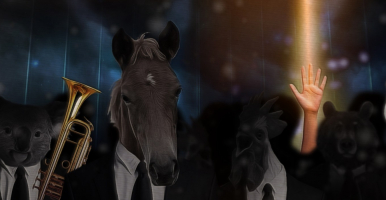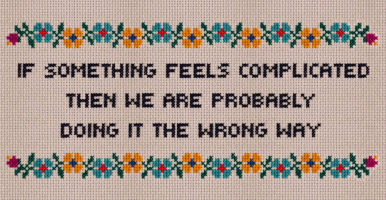5 simple steps that will make you a creative genius
No doodling, inspiration or walks in the woods requiredI met a friend the other day and told her that I was writing an article about creativity. She is the embodiment of creativity: former dancer, amazing photographer, landscape designer, inventor and more. She knows all about the practical side of creativity.
“An article about how to become creative” I clarified. She started laughing. It was clearly an odd thought in her mind. Why would you have to read about something that happens by itself all the time? I changed the subject.
A General Theory of Creativity
Creativity fascinates me, and writing about it has been on my todo list for some time. Personally I have come to trust my own internal creative process over the years, but have not had any reason to look at it in detail. That is, until now.
I had to dig deep into my brain for some answers. What is creativity? How does it work? Creativity in the arts and in science, does it work the same way? Would my way of thinking make sense and be useful to someone else?
Here is the result. It is a process that covers all necessary steps in the creative process in a general way. Sticking to my 7 minutes of potential fame it only scratches the surface. Each step deserves its own article, now on the todo list!
Before I started
What do you do if you want to become more creative? You do a search for “how to become more creative” of course! Which I did just to make sure that I did not re-invent the wheel. 668 million hits! The advice I got (first page only) fell in one of four categories:
- do things that are considered creative, doodling seems to be the top choice. And if you are doodling then you are already creative. Mission accomplished? Yeah, if doodling was what you set out to do.
- mimic what (some) creative people do. Like keeping a notebook always at hand because there could be an idea any minute now (yeah right!)
- practice some abstract skill, like being more open or playful or… (no comments)
or they get stuck in trying to define what creativity is without much luck.
There are some good thoughts here and there but overall the advices are far too abstract to be of help. No wheels anywhere in sight. Awesome!
The five steps
Encouraged by the lack of substance, here are my 5 steps to become a creative genius. It doesn’t rely on doodling, showers or walks in the woods. It doesn’t even rely on inspiration, that fickle state that never materializes when you actually need it.
Creativity is a mindset that can be nurtured. The steps below will give you a process and structure in which this can happen.
Step 1: Realize that there is a problem
I would argue that without a problem to solve there is no way to actually be creative (you can challenge me on that 🙂). The problem shows us the opportunity.
It is not always easy to notice this opportunity when we are totally overwhelmed by just getting things done. We have to stop doing, take a step back and have a look at things from the outside. If everything moves ahead according to plan then there is nothing to worry about but…
If something feels complicated then we are probably doing it the wrong way.
It is that hunch that makes us think: “there must be a better way”. I call this the Innovation Trigger and it is a sure sign that you have an opportunity to get creative. I have covered this more in depth in this article
If something feels complicated…Creating a mindset for problem solving and innovation. Also about elephants.
Step 2: Define the problem
Every day there are small and big problems that just begs to be solved. Overcoming your shyness, building a reusable space rocket, bringing peace to the Middle East. Creativity doesn’t mind or judge, creativity LOVES problems!
Defining the problem is essential for the creative process. If you don’t know what the actual problem is, how could you possibly solve it?
Start with writing down what you think is the problem, then look at it from another angle and rephrase the problem. Remember that our beliefs and hopes can make it really hard to see things as they are. Be honest.
If you have defined the problem as something that you cannot control, then it is of course impossible to solve. Change perspective and rephrase.
When you think you have nailed it then it is time to come up with solutions. So where are the ideas?
Step 3: Guess the solution
You probably did not learn this is school but here’s the truth:
You have to GUESS the solution to the problem!
Think about it. We are about to come up with a solution that doesn’t exist yet, that means per definition that we cannot know anything about the solution. And if we cannot know, what do we have to do then? We guess!
“But I don’t know what the solution is!” you might say, proving my point. Of course you don’t know! That is why you have to guess! “But I can’t guess!” your uncreative self image might argue, to which I respond: if you had to guess, if your life depended on guessing, what would you guess?
Guessing is how we access our intuition. In the beginning you might feel a lot of reluctance to start guessing but with practice it will become effortless.
When you have one or more good guesses about solutions, then you are ready for the next step.
Step 4: Just do it (until you realize you are on the wrong track)
Ideas are tested by doing!
So you guessed your first solution to the problem, congratulations! But is it a good guess? Who knows! The only way to figure out is to go with it. What do you have to do to put the solution to the test?
Doing is essential, getting some notes down on paper, some paint on the canvas, some dirt under your nails. It is not until the idea is getting concrete that it becomes obvious if it is a good or bad idea.
Being wrong is an essential part of the process
It is not until after you have found a creative solution that it all makes sense. Up until that point there is more or less uncertainty, and we cannot know just yet.
Just to be clear, “know” doesn’t mean “think”, “hope”, “want”. “Know” means “you can cut off my head if I am wrong”. With that definition, how much do we actually “know” (rhetorical question, no need to answer)? Until we have solved the problem we just have to be very aware that we are working with theories and assumptions.
If you want to become more creative, get used to not knowing and be prepared to be wrong.
And when you are (wrong) …
Keep on doing until you realize you are on the wrong track. And how do you notice? Here is a warning signal:
If something feels complicated then we are probably doing it the wrong way.
Take a step back and check if things are moving in the right direction. If it does, then get back to work, if not then there are two options and two options only:
- you have guessed the wrong solution
- you are trying to solve the wrong problem.
No other options! First have a look at the solution, does that based on what you know now seem as good as it did before? If it doesn’t, guess again, if it does, then you have to revisit the problem and redefine it. Remember to scrap the solution after that since it was based on the wrong problem.
Step 5: If you reach this step then you have already solved the problem!
When you are not (wrong)…then you are (right)!
Congratulations, you have solved the problem! You have not only been genuinely creative, you have changed the world to the better! Money and fame to you!
Have you become a genius? It depends on what you created. If not this time, surely the next!
To conclude
Here are the steps:
- Realize that there is a problem
- Define the problem
- Guess the solution
- Just do it until you realize you are on the wrong track, then go back to step 3, if that doesn’t help go back to step 2, remember to redo step 3
- If you reach 5 then you have solved the problem! Congratulations!
5 steps to creativity, simple enough! Makes sense? Have some questions? I’d love to hear what you think!
Each step in the process has lots of challenges and opportunities, and it is easy to get stuck or question your decisions. I am planning to add new articles about each step with practical advice, tactics and answers to any questions.





